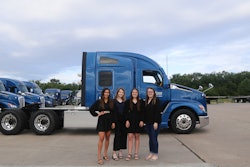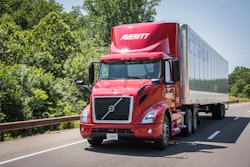
CCJ Innovators profiles carriers and fleets that have found innovative ways to overcome trucking’s challenges. If you know a carrier that has displayed innovation, contact CCJ Chief Editor Jason Cannon at [email protected] or 800-633-5953.
At Garner Trucking’s Findlay, Ohio, terminal, there is a truck changing station where drivers can park a truck on each side and walk straight across from one truck to the other as they move their belongings between the two instead of having to climb up and down the stairs of each truck carrying items in their arms, creating a fatiguing and potentially hazardous situation.
This is just one purchase the company’s driver advisory board has made in recent years, backed by a budget the company allots the board to make moves that improve driver quality of life.
The company had what it called a driver council in the early 2000s, and while it gave drivers the opportunity to come together, Garner Chief Operations Officer Tim Chrulski said it didn’t go quite as planned.
When drivers would share their insights, the company “would look at those items and give them the reasons why we couldn't do this or that, and it never was really very constructive,” Chrulski said. “It allowed for the feedback, but then we weren't really reacting.”
So Garner Trucking, in the late 2010s, relaunched its initiative with a completely different mindset and put some money behind it.
The company’s driver advisory board is made up of six drivers – with room for a seventh right now – that meet on a quarterly basis in person half the time and via Zoom the remainder. The board is also called upon when the company is considering things like implementing a new technology or policy. Each member serves a two-year term before finding their own replacement, including the chairperson. Chrulski said this keeps things fresh with new ideas circulating. And when an idea is presented to the board – whose members are also tasked with keeping contact with fellow drivers for their input – he said a lot of discussion and consideration comes into play before the board votes on a new measure.
The board has also voted to build a driver lounge and to give back to its drivers with gift cards, among other things. And it implements these things with its own money. Chrulski said the company doesn’t take funding from the board’s budget for things like stocking the driver lounge with snacks, coffee and drinks.
Many trucking companies have a driver-based group that provides feedback, but it’s rare to find one that has its own budget. Garner allocates a defined budget annually to the driver advisory board. Though Chrulski couldn’t share the amount, he said “it’s a pretty significant number” that has remained the same since the program’s inception, and the board either uses it or loses it each year.
Chrulski said Garner’s owner, Sherri Garner Brumbaugh, felt strongly about backing the board with a budget in order to actually navigate some change for drivers.
“You put teeth into a program when you start to put some dollars into it,” he said. “So the driver advisory board has a much more proactive way of doing things, addressing the issues and problems or the shortcomings that they perceive or see, and then they have a budget to back that up so they can actually execute those things.”
And it’s entirely up to the board how they spend the money.
While the management team is present during meetings, Chrulski said it isn’t allowed to tell the board how to spend its money or give the board reasons why they can’t accomplish something.
“We, as management, are there to help kind of guide those conversations. The sole function there is for education, to weigh in on topics and to be supportive of that group,” he said. “It's our job to make those things happen – figure out how to instead of how not to.”
And the board hasn’t run into anything yet that it hasn’t been able to accomplish, he said, though some things take more time than others. For example, the board is currently pushing for Wi-Fi in the trucks. It’s just taking longer because it requires the company to look at its current software system and agreements and those types of things, and make some adjustments and changes to make it happen through upgrading or purchasing another solution.
But it is getting harder to spend the money, Chrulski said.
“Like with many things, when there's some low-hanging fruit, I think it's a little easier to spend the money. Whereas in the last year or so, it gets a little more difficult because they've achieved so much over the last several years that there is less and less to spend money on,” he said.
But it doesn’t always boil down to money. The board more recently has turned to policy changes. Chrulski said the board has been pushing for a 401(k) match that will now go into effect next year. Another instance was implementing a pet policy that would allow drivers to take their pets on the road.
Those are things the company can actively go out and sell to recruit drivers, but that’s just a side benefit. The value of a budget-backed driver advisory board has gone well beyond that, giving drivers a sense of ownership, Chrulski said.
He said it has allowed the company to convey its willingness to not only listen, but to act.
“I think a lot of times organizations think they know what their drivers want or what they need, but if you don't have that advisory level, you're never really going to find out for sure,” he said. “Until you can display to your drivers that you're serious about listening to their intentions, listening to their needs and doing something about it, no program like that is going to work.”
For companies that are considering implementing a budget-backed driver advisory board, Chrulski had some recommendations.
He said don’t go into it with a “no” mindset, only offering reasons something can’t be done rather than working to make something happen. Another important element is allowing the drivers to lead with minimal guidance from management. He said it’s also essential to communicate with the entire organization what is happening in these meetings. But the biggest key factor, he said, is building a diverse group.
Garner’s group includes young and older drivers, first-year and senior drivers, men and women and people of different race to represent the company’s 95 drivers.
“First and foremost, we wanted to make sure that the board itself was well-rounded … so that we were contributing something from all angles and trying to improve the organization, not just for one group, but for all groups,” he said.
Chrulski is a former driver himself, but he said even if management is made up of former drivers, they can’t know what drivers today are going through and what they need based on their own history. They have to hear it directly from current drivers.
“The budget itself is intended to achieve the things that the driver advisory board wants to achieve – the things they see are necessary, that they want and need versus it being about the organization trying to figure out what they need and then spending some money only to find out ‘okay, this doesn't make sense,’” he said.
The CCJ Innovators program is brought to you by Bendix, Comdata, Freightliner Trucks, SkyBitz and Valvoline.












